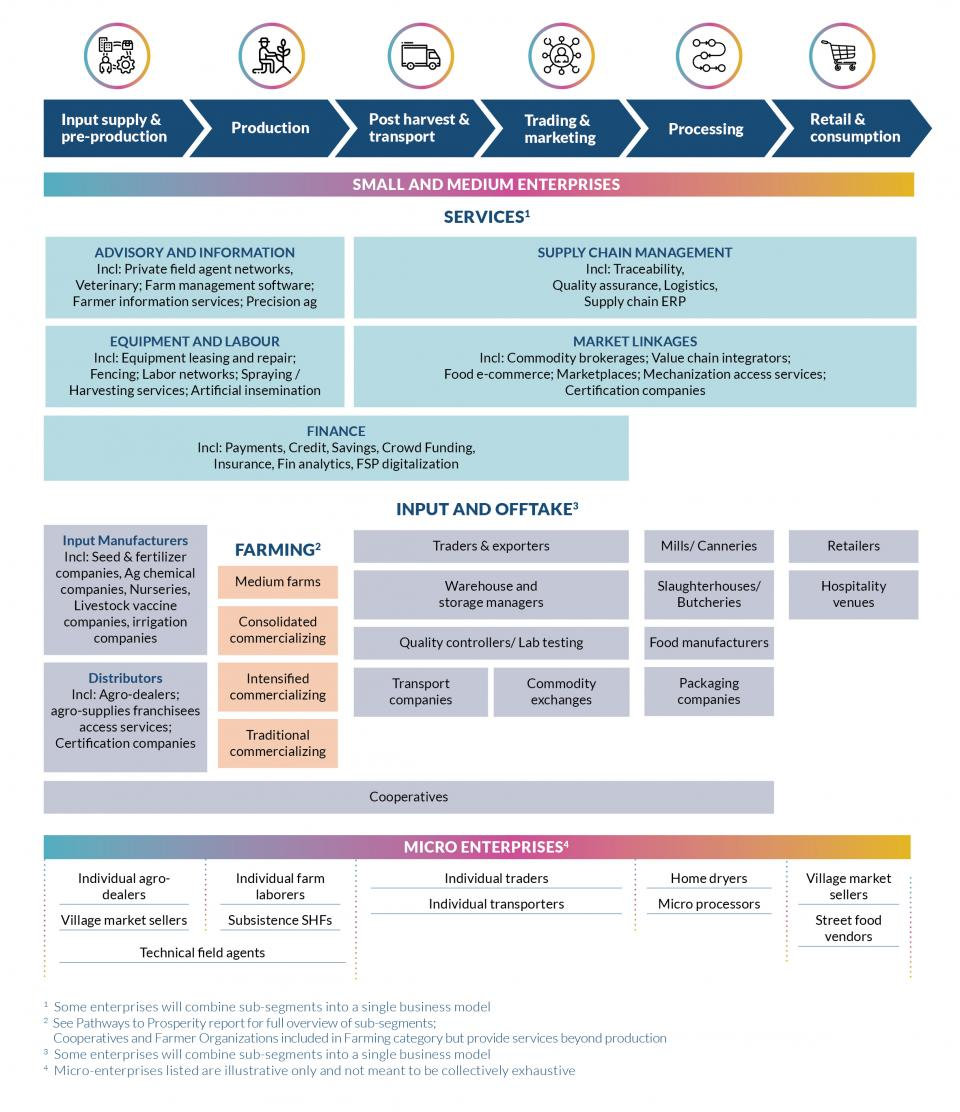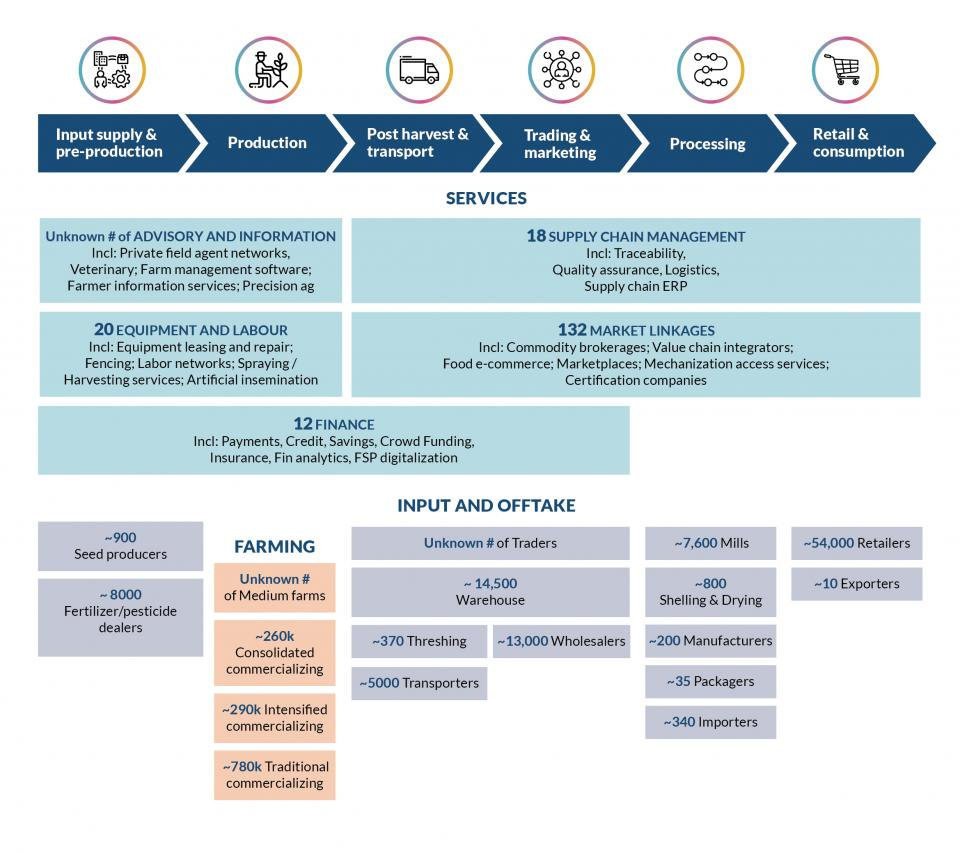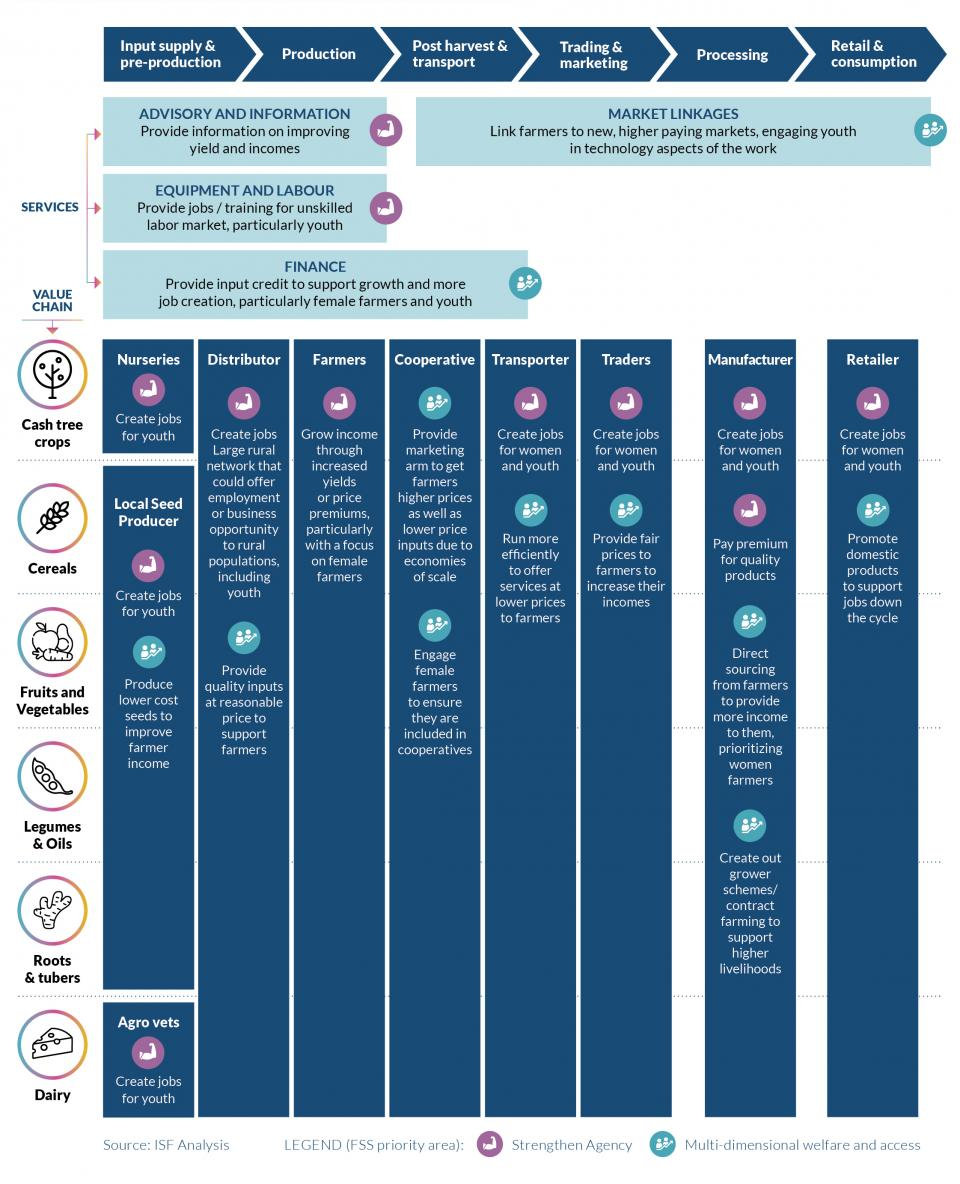Agricultural small- and medium-sized enterprises (agri-SMEs) are critical to the development of more inclusive and sustainable food systems. These businesses are responsible for much of the sale of inputs, food production, collection and distribution, and processing and retail of food products. However, the absence of a widely shared definition and comprehensive taxonomy of agri-SMEs stymies our view of their role in food systems. With a shared framework and language, we could more comprehensively consider the role of different types of agri-SMEs in food systems, as well as the specific types of support that would unlock their growth potential.
SAFIN commissioned ISF Advisors to develop a framework for more comprehensively considering agri-SMEs, with the goal of creating a common language that:
-
Fosters a shared understanding among actors concerned with agri-SMEs (including, but not limited to, financial service providers) about the shared features of different types of enterprises that fall under this label.
-
Proposes a new taxonomy and language to establish agri-SME segments—drawing on existing case studies and literature to illustrate how these might apply in different markets.
-
Provides a solid grounding for the assessment of different financial needs of agri-SMEs, which can inform SAFIN’s work, as well as that of other relevant actors in the agri-SME finance space.
ISF Advisors conducted a literature review of more than 80 publications, as well as consultations with key experts, including SAFIN members. This research highlights the importance of agri-SMEs in the food system, building off of current classifications of agri-SMEs to create a more comprehensive taxonomy based on key profiling dimensions. It also shows the applicability of the taxonomy across value chains and various food systems priority areas. Finally, this research presents a growth profile classification to link the agri-SME taxonomy to investability criteria and needs, allowing for a more nuanced understanding of how best to support specific segments of agri-SMEs.
A comprehensive agri-SME taxonomy
Over the last several years, significant work has been done to further understand agri-SMEs; yet this work has largely been limited to smallholder farmer, input and offtake, or service agri-SMEs. To create a more comprehensive taxonomy, this work has combined the existing, extensive segmentation within each of these agri-SME types and mapped them based on their role along the value chain. While this taxonomy will benefit from continued iteration and refinement as new business models and actors emerge, it is a useful foundation for analyzing the needs of agri-SMEs across previously siloed categories.

Image: ISF Advisors
As can be referenced in the full learning brief, there are a number of explanatory notes that accompany this taxonomy which clarify the distinctions that have been made. Drawing from these, we highlight four key insights about the landscape that are made more transparent through this taxonomy:
-
Micro-enterprises support many of the same functions in agricultural value chains, but at a much smaller and more informal level. Considering these differences and viable pathways for micro-enterprises to “transition” to the level of an agri-SME is an important part of how many agricultural markets will continue to develop, and should be an area of continued research and support.
-
Many smallholder farmers are currently operating at a level that is comparable to many other agri-SMEs with an investability profile that largely depends on the type of operation they are running. Building on the important segmentation and pathways work that has been done over the past few years is an important way of continuing to “crack the nut” on how to support the growth of these primary producers.
-
In this taxonomy, Services agri-SMEs have been separated from Input and Offtake market agri-SMEs. The authors acknowledge that there are other ways of considering these distinctions, and that considering the market in this way is more of a reflection of how these different types have been considered in the past. While not true in all cases, for the most part Services agri-SMEs tend to operate across value chains with more of a tech focus in service delivery than Input and Output agri-SMEs. Acknowledging these distinctions can be useful in connecting funder communities that have historically been quite separate in where they have focused.
-
While agri-SMEs in this taxonomy are categorized through functional distinctions, in reality many of these agri-SMEs will run enterprises that combine different functions into a single business. Considering typical vertical and horizontal integrations of different business models is another important lens to put across this taxonomy.
Applications of a Comprehensive Taxonomy
There are a number of benefits to having a comprehensive taxonomy of agri-SMEs, but it is important to account for the ways in which the applicability of this taxonomy may differ across value chains and markets.
For example, in the case of rice in the Philippines: As with most staple cereal crops, the rice sector has many farmers and traders, but few processors. Given the large number of consumers, there are also many millers and retailers in the sector, though most are on the smaller end. Despite being a large producer of rice, the Philippines is also a net importer due to high demand—this is also typical of staple cereals writ large, which makes importers an important actor in these value chains. Finally, service providers in the Philippines’ rice sector are limited and focused on market linkages, again due to a large number of consumer transactions. The graphic below illustrates this case example.

Image: ISF Advisors
The way in which this agri-SME market landscape differs from other types of value chains (such as cash tree crops, fruits and vegetables or dairy) reveals a type of market “blueprint”. This type of SME blueprint can help actors trying to transform food systems better understand the types of agri-SMEs that exist in different markets, as well as their unique needs.
Supporting different food system outcomes
Looking beyond specific value chains, the taxonomy can also be applied to specific market development objectives to understand the different roles that agri-SMEs can play in advancing those objectives. For example, the graphic below illustrates how the taxonomy can apply to the UN Food System Summit’s Action Track 4: Equitable Livelihoods. This creates a clear way to map agri-SMEs with the greatest potential to support this action track. The map can also be shared with partners who may not be familiar with the agri-SME space, enabling them to see the linkages and potential interventions that might be needed.

Image: ISF Advisors
Conclusion
This learning brief continues the critical work of considering agri-SMEs as a distinct and definable set of enterprises, with implications for global agendas related to both SME growth and food systems transformation. We acknowledge that this is only the beginning of creating a shared definition and useful taxonomies in a sector loaded with complexity. We hope this brief forms a basis for further work and conversation related to:
-
A comprehensive taxonomy of agri-SMEs, including how to continue refining the segments and sub-segments, and how to think about integrated business models.
-
Defining agri-SMEs, including the global importance of an aligned language, as well as the complexities of developing thresholds and ways of considering national variation.
-
The different growth profiles of agri-SMEs, including whether the six segments adequately cover the range of agri-SMEs in the market, and how such a tool could better align support—both with agri-SMEs and between collaborating organizations.
-
How to better align with different food systems summit outcomes and use a shared understanding of agri-SMEs to consider the value of big intervention ideas, including around women and youth.
This article was originally published by ISF Advisors.

